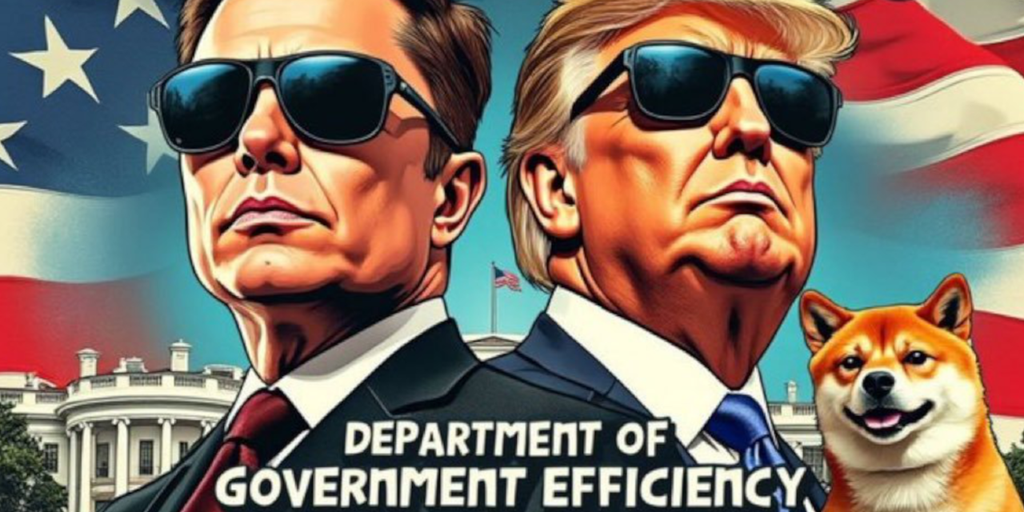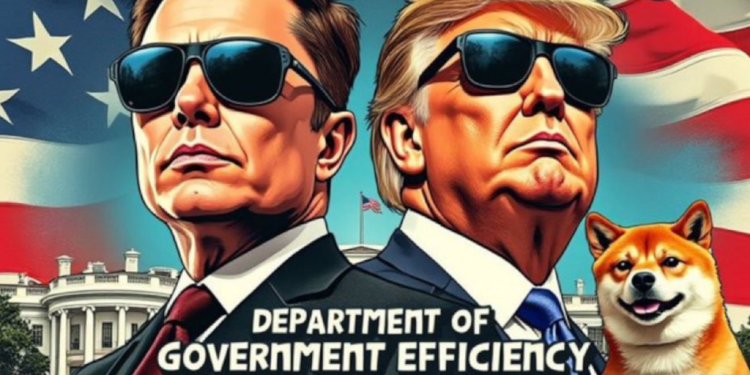
SpaceX CEO Elon Musk is helming a new U.S. government initiative aimed at lowering the federal budget deficit.
Called the Department of Government Efficiency (DOGE), the initiative—which has an acronym identical to the ticker of Musk’s favorite cryptocurrency, Dogecoin—will “slash excess regulations, cut wasteful expenditures, and restructure Federal Agencies,” according to President-elect Donald Trump.
Here’s everything you need to know about DOGE.
What is DOGE?
DOGE is a U.S. government initiative that Elon Musk first tweeted about in August 2024.
Musk originally intended to run the agency alongside fellow billionaire and businessman Vivek Ramaswamy. However, Ramaswamy stepped back from DOGE in January, amid reports he planned to run for Ohio governor.
While the project initially appeared to be a joke—created as a gag, and unsurprisingly pumping the price of Dogecoin whenever mentioned by Musk—Trump threw his support behind DOGE’s push to curtail government spending, saying that the once-fictitious department would actually become a real-life U.S. government-affiliated entity.
“Together, [Musk and Ramaswamy] will pave the way for my administration to dismantle government bureaucracy, slash excess regulations, cut wasteful expenditures, and restructure federal agencies—essential to the ‘Save America’ movement,” Trump said in a statement.
The project will be active until “no later than July 4, 2026,” Trump said; that’s the 250th anniversary of the signing of the Declaration of Independence.
Notably, DOGE is not an official U.S. government department in the traditional sense, as only Congress—not the president—can approve the creation of new federal government departments, according to the U.S. Congress’ website.
Rather, Musk’s meme-linked brainchild will exist “outside” of the government system, Trump said. That means DOGE will likely not receive government funds. It also means that the project’s ability to directly control U.S. government agency budgets will be minimal, although DOGE’s directives could be implemented by Trump’s supporters in Congress.
Who is running DOGE?
Musk is leading the charge at the Department of Government Efficiency. He will not receive compensation for his work, according to a Twitter post that Musk published.
Musk, of course, is the CEO of Tesla and SpaceX, and the owner of X—the social media platform formerly known as Twitter.
The initiative is staffed and shepherded by at least 30 people, ProPublica reported. Its roster includes former X and SpaceX employees, venture capitalists, lawyers, and young tech founders.
Meanwhile, billionaire Marc Andreessen of venture capital giant Andreessen Horowitz has been recruited to act as DOGE’s “key networker for talent recruitment,” the Washington Post reported, citing an anonymous source.
Musk has also allied with several Silicon Valley bigwigs to address “technical challenges to collecting data about federal employees and programs”—a major problem that the initiative aims to resolve, according to the same report. Those advisors include Palantir co-founder Joe Lonsdale and hedge fund manager Bill Ackman, the paper reported, citing multiple people familiar with the matter. Airbnb co-founder Joe Gebbia is also consulting for DOGE.
What does DOGE actually do?
DOGE’s mandate is to streamline the U.S. government by issuing reports that provide advice and guidance on trimming government regulations and spending, according to Trump.
“Your money is being wasted, and the Department of Government Efficiency is going to fix that. We’re going to get the government off your back and out of your pocketbook,” Musk said in October at a rally for Trump at New York City’s Madison Square Garden.
The quasi-department plans to accomplish that task by pushing its cost-cutting proposals through Congress. Musk and Ramaswamy could also present their ideas directly to Trump, who has the power to circumvent Congress and issue executive orders that would call for the implementation of DOGE directives.
While critics have expressed doubts as to how much change DOGE will be able to effect, it has become increasingly likely that its budget-slashing measures will get at least some play in Congress. In late November, GOP congressmen formed the Congressional Delivering Outstanding Government Efficiency (DOGE) Caucus, which will champion DOGE directives on Capitol Hill.
Musk has given differing statements over the extent to which the U.S. federal government’s spending should be slashed. He previously suggested reducing federal expenditures by $2 million—a third of the U.S. federal government’s total budget.
However, he has since backtracked on his grandiose claims, saying in January that cutting $2 trillion from the federal government was actually unlikely. He called it a “best-case scenario” in a video interview on X, but said instead that there’s a “good shot” of finding $1 trillion worth of cuts.
Despite the uncertainties, DOGE’s work is well underway. Under Musk, the initiative has slapped an agency tracking U.S. students’ academic progress with $900 million in cuts, along with slashing more than $100 million for funding DEI initiatives spearheaded by the Education Department.
Its plans also include axing scores of federal government employees and several U.S. agencies, such as the Department of Education and the Federal Bureau of Investigation (FBI), to cut costs. An NBC News report in February said that DOGE will use AI tools to evaluate federal employees to determine whether or not they should keep their jobs. This comes after Musk’s headline-dominating emails to employees, demanding that they share what they’d accomplished the previous week.
“The magnitude of the [government funds] waste is beyond what the public could possibly imagine,” Musk tweeted last November, referencing U.S. federal government spending, which topped $6 trillion in 2023.
To facilitate its cost-cutting efforts, DOGE has gained access to the Bureau of the Fiscal Service’s systems, which distribute roughly $5 trillion in payments to federal workers and other payees.
However, 13 states sued DOGE in February to block its access to those government payments systems, leaving unclear the extent to which Musk’s team has access to federal data.
Why is it called DOGE?
The faux department’s initialism, DOGE, appears to be a cheeky reference to the ticker for Dogecoin (DOGE), a high-market-cap meme coin beloved by Elon Musk. That link was reinforced by an official t-shirt sold by Trump featuring the president-elect, Musk, and a Shiba Inu dog.
The meme, which is famous for its Shiba Inu mascot, was invented in 2013 by a pair of software engineers. Musk has said that he owns a “bunch” of Dogecoin, and he has tweeted and spoken about the coin routinely over the past years. He even called himself the “Dogefather” in 2021 and mentioned the coin while hosting Saturday Night Live.
Dogecoin’s value climbed amid Musk’s support for Trump on the campaign trail, and then skyrocketed after Trump’s win and amid the official announcement of DOGE leadership. The coin hit a three-year-high price in December and has helped spur other notable meme coins to surge in value, as well.
In January, the official DOGE government website displayed the familiar Doge meme image—a move that helped pump the coin yet again. However, it was a short-lived jump that was reversed when the image was pulled the following day.
Musk’s DOGE push has proven to be divisive amongst ardent fans of the Doge meme and Dogecoin, as Decrypt reported in March, as the agency’s cuts carry political weight and have potentially dramatic consequences—a real shift from the fun, vibes-driven approach of the community.
What’s the latest on DOGE?
DOGE is expected to undergo a leadership overhaul after Politico reported on April 2 that Musk “will be stepping back in the coming weeks” from his role as an advisor to President Trump, citing three sources familiar with the matter.
Prediction market traders on MYRIAD foresee a nearly 17% chance that Musk will leave DOGE by the end of the day on April 17. (Disclosure: MYRIAD is owned by Decrypt’s parent company, DASTAN.)
In any case, Musk is expected to lose his designation as a “special government employee, which has allowed him to helm his cost-cutting initiative, in the next few weeks. However, he could still play a role in the current administration, albeit in a more limited capacity.
In other news, DOGE’s deep cuts to federal government agencies’ workforce have continued in recent weeks.
Most recently, the extra-governmental agency pushed for layoffs of nearly all employees at the U.S. Institute of Peace, a federal government-funded think tank. The near-dismantling of the agency comes after a federal judge ruled in favor of DOGE’s bid to overtake the agency’s building in mid-March.
As of this writing, the initiative claims to have terminated more than 7,200 government contracts worth $25 billion, and also claims to have scrapped over 9,200 grants worth roughly $33 billion from the Department of Education, Environmental Protection Agency, USAID and the Department of State, among other agencies, according to the DOGE website.
Edited by Andrew Hayward
Editor’s note: This story was originally published on November 17, 2024 and last updated with new details on April 5, 2025.
Daily Debrief Newsletter
Start every day with the top news stories right now, plus original features, a podcast, videos and more.
#Elon #Musk #DOGE #Department #Government #Efficiency
























